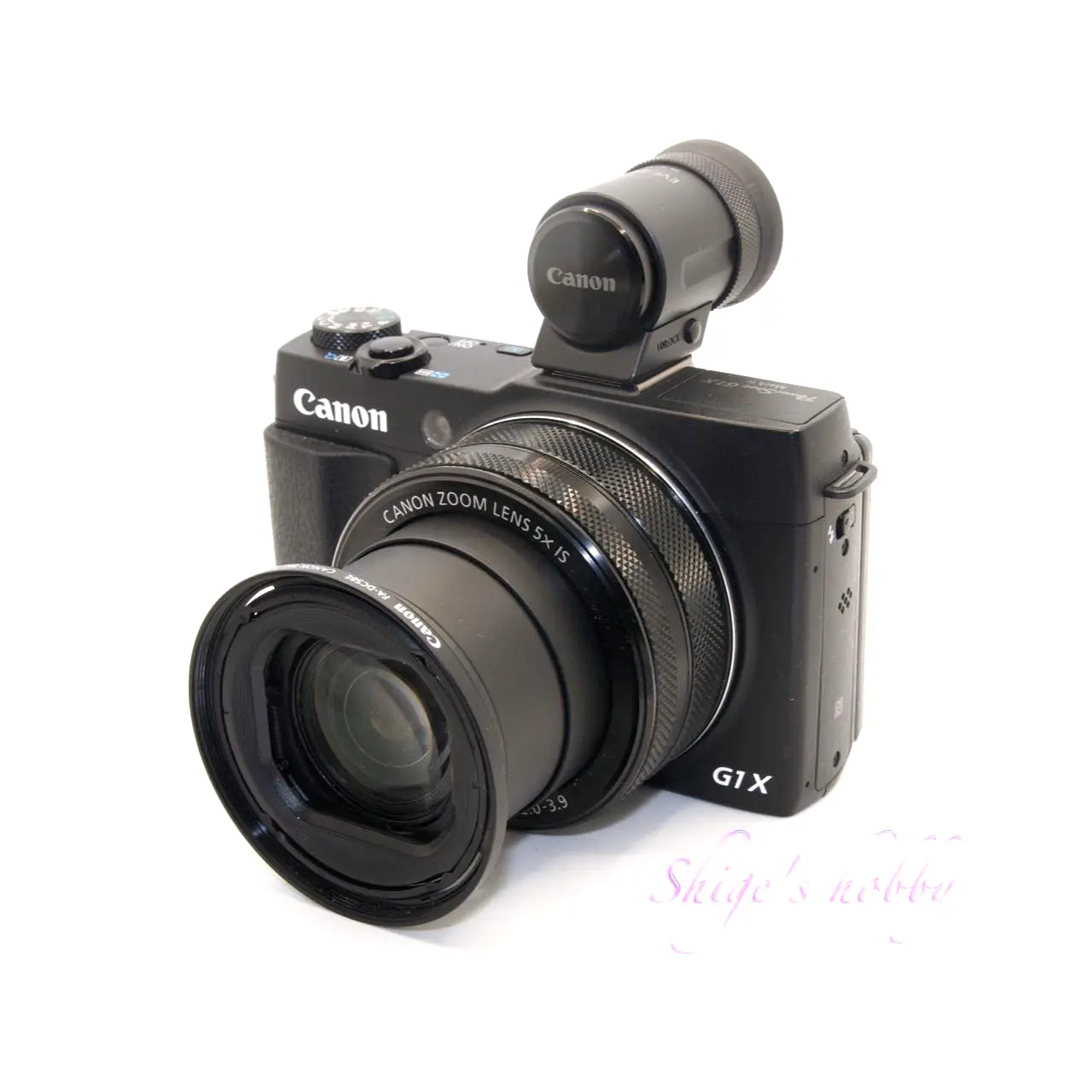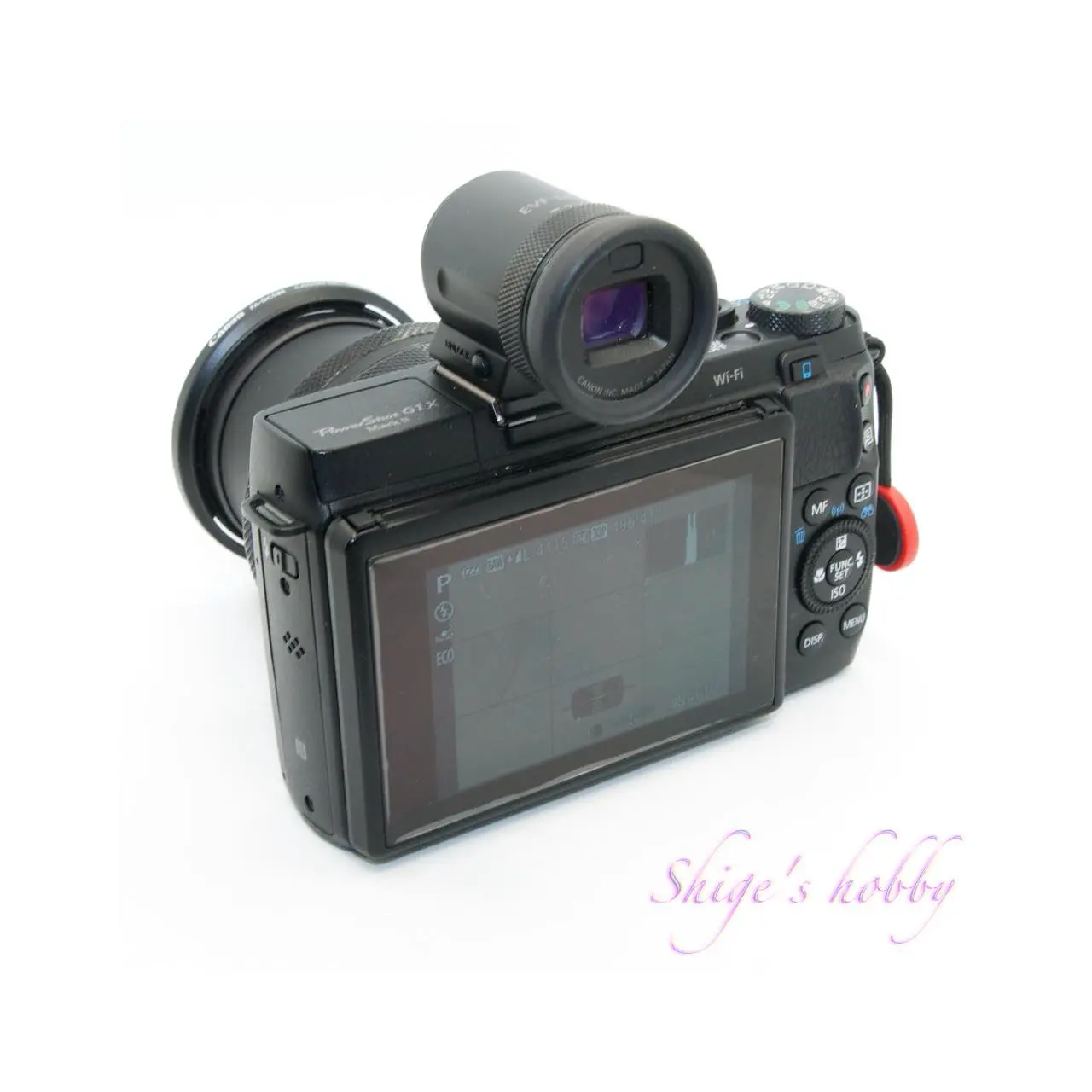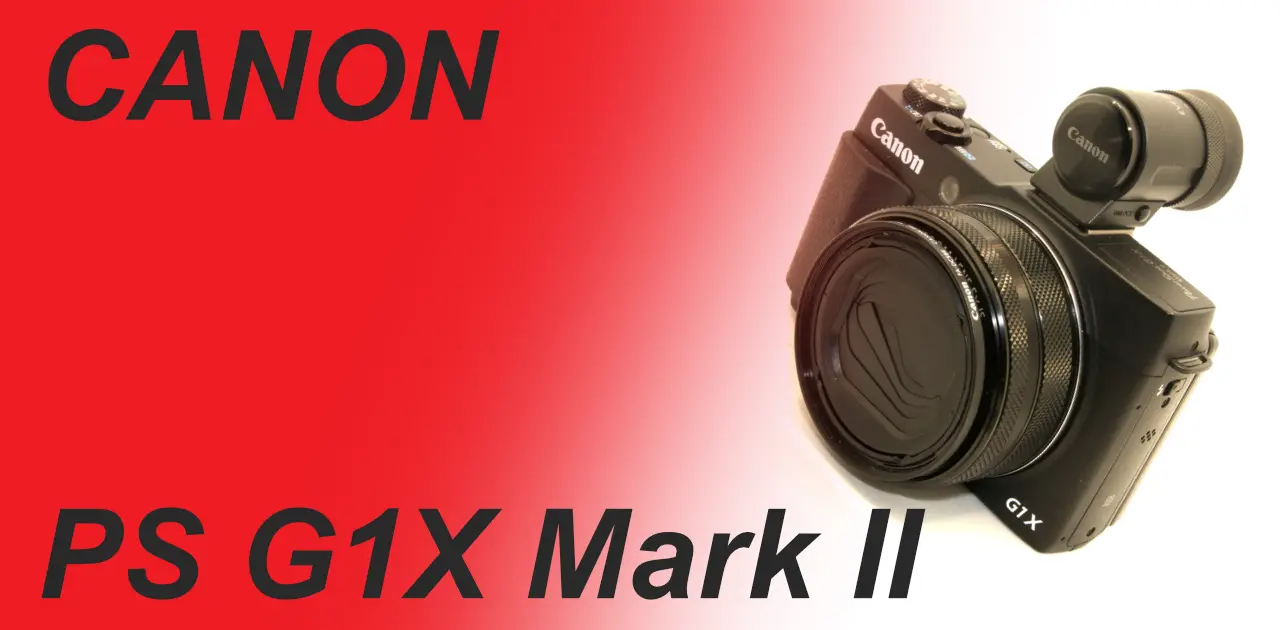Last updated on 2025-10-26
A review and photo examples of the PowerShot G1X mark II.
Table of contents
Gallery
Review


1.Overview
The Canon PowerShot G1X Mark-II (G1X2) was released in 2014 and is a lens-integrated digital camera with a 1.5-inch sensor, which is larger than the sensor size of Four Thirds and Micro Four Thirds cameras.
It is the second-generation camera in the top-class G series of the PowerShot series, and has a 1.5-inch sensor, a 24mm-120mm 5x zoom lens, an add-on EVF, and a pixel count of 13.1 megapixels at 4:3.
It uses the DIGIC 6 image processing engine, and the lens configuration is 11 groups and 14 elements, including one double-sided aspherical lens and two double-sided aspherical UA lenses, with multi-layer coating. The lens is equipped with an optical image stabilization mechanism (IS) with a correction effect of about 3.5 stops, and the minimum shooting distance is 5cm in macro mode at the wide-angle end and 40cm at the telephoto end. The front of the lens is equipped with a lens protection shutter that opens and closes automatically.
Images are compatible with Raw format with the CR2 extension and JPG. The maximum resolution is 4160 x 3120 pixels in 4:3 RAW mode. Videos can be recorded at a maximum resolution of 1920 x 1080 (24 fps).
The dedicated bayonet-type LH-DC80 hood is required, and the FA-DC58E adapter is required to attach a 58mm diameter filter.
These two options are mutually exclusive and cannot be used simultaneously.
The battery is an NB-12L with the following specifications:
| Selected products | PowerShot G1 X Mark II / N100 |
|---|---|
| Product Type | Lithium-ion rechargeable battery |
| Nominal Voltage | DC 3.6V |
| Nominal Capacity | 1910mAh |
| Nominal Power Capacity | 6.8WAh |
| Charging time | 3 hours 5 minutes* |
| Charge/discharge cycles | 300 times |
| Operating temperature | 0-40℃ |
| Size | 34.4×48.5×10.4mm |
| Weight | 35g |
The price of the camera body was open, and the price at the time of release was just over 90,000 yen.
2.Usability
The CANON G1X Mark-II is Canon’s second-generation high-end compact camera, which has resolved the complaints of the G1X but left some unsatisfactory points unresolved.
One of the complaints is the lack of a built-in viewfinder. However, the optical viewfinder of the G1X was useless, so if the optical viewfinder was to remain, it was unnecessary and I would have preferred an EVF. The removal of the viewfinder has made the body smaller than the G1X, and it is closer to the size of a compact digital camera, which is a good point.
The exterior of the body is plastic, but the surface treatment gives it a certain luxury feel.
The G1X Mark-II is the last camera with a lens-integrated camera equipped with a 1.5-inch sensor, and the G5, G7, and G9 series have 1-inch sensors. The G1X Mark-III is equipped with an APS-C size sensor, which has increased in price and is undeniably excessive for a lens-integrated camera.
These new cameras released in the same year have few second-hand cameras, and both second-hand and new prices are stable at high prices, so if you are looking for a camera with a large sensor size, the first G1 series and this Mark-II are strong choices because they are relatively reasonably priced.
There are some doubts about the camera’s operability, so whether you can tolerate this quirk or not will be the deciding factor in whether you can continue to use this camera. Fortunately, although there are complaints about the operability so far, it is a valuable large sensor camera that is useful for everyday snapshots.
The large 1.5-inch image sensor installed is not dissatisfied with the image quality, just like the old G1X.
As an improvement from the G1X, the focal length of the zoom lens of the G1X Mark-II has been increased from 24mm at the wide-angle end to 120mm at the telephoto end. The G1X starts from 28mm, and the fact that the wide-angle end is 4mm wider makes it very easy to use.
In terms of focal length, the G1X Mark-II completely eliminates the dissatisfaction with the G1X. Another good point about this camera is that the maximum aperture is F2 to F3.9, making it bright.
Lens distortion is properly corrected from the wide-angle end, and there is no noticeable distortion even when shooting square objects. It is a good improvement that the lens can now get as close as 5cm, the minimum shooting distance at the wide-angle end. However, it is not possible to take the minimum shot seamlessly, and when taking macro shots, the camera settings must be changed to macro mode.
The rear LCD screen can be tilted up and down 180 degrees up and down and 45 degrees down, so there is no freedom of vari-angle. Also, the frame of the tilt LCD screen is delicate and lacks rigidity, so it is a little scary to use it as it may break. Of course, dropping the camera is out of the question, but if you are unfortunate enough to drop it with the frame unfolded, the frame will definitely be distorted or damaged.
The LCD screen is large at 3 inches, and the 1.04 million dot resolution is a display performance that allows you to visually check the focus position.
The EVF is external (EVF-DC1, EVF-DC2), and when attached to the camera, it does not feel like a part of the camera, and the entire camera becomes larger, making it difficult to store in a bag, so I would prefer the EVF to be built into the camera.
The best way to mount the EVF on a compact camera is not to ostentatiously mount it on the pentaprism like the G1X Mark-III, but to mount it smartly on the upper left of the camera, integrated into the body, like the α6×00 series, the higher-end camera in the Sony α NEX series.
I tried using the EVF-DC2, which was included with the purchase, and found that if you use it calmly, the autofocus and focus position are reasonably accurate and can be checked sufficiently on the rear LCD screen, so the only time you need an EVF is when you take it outside on a sunny day.
Operation has been improved compared to the G1X, and you can assign functions to the two rings on the lens barrel to perform the desired operation to a certain extent.
When shooting, the step ring, which has a clicky feel, is assigned to the step zoom, which switches in stages from 24, 28, 35, 50, 85, 100, and 120, and the smooth ring, which has no clicky feel, is used to interrupt manual focus.
The above setting is a compromise, and although I would like to use the smooth ring to operate the zoom, I cannot assign zoom operations to the smooth ring. This is an area I would like to see improved.
Since the two rings on the lens barrel are used in the above setting, exposure compensation is controlled with the flat ring next to the LCD.
This flat ring is not very user-friendly, so it would be better if the camera had a dedicated exposure compensation dial on the camera’s front panel like the G1X.
It seems that the design concept of the G1X Mark II made it impossible to place a dial on the front panel, but the sub-dials embedded in the body of the EOS R are easy to operate.
As for the camera’s button layout, the layout is cramped because it has a reasonable number of buttons on a small body. I would like them to reconsider the position of the MF button in particular.
It would be nice to have a mechanism to switch between autofocus and manual focus, like Sigma’s slightly older lenses, with a mechanical switch at the base of the lens barrel.
As for operation, it feels like you have to wait a moment after turning it on before you can start shooting.
The AF speed is not that fast and the focusing accuracy is average, so it’s fine for taking landscapes or table photos at a leisurely pace, but it often can’t keep up with instantaneous shutter opportunities.
The image recording time after shooting is not like the high-pixel cameras of the late 2000s, where you have to wait 5 seconds for RAW shooting, and there is no impression of waiting for 13-megapixel RAW + highest quality JPEG recording, and you can feel the benefits of the DIGIC6, which handles image processing.
The battery, NB-12L, is unique to Canon, and is only used in the G1X2 and the PowerShot N100, which didn’t sell well. I have seen compatible products made overseas, but they also cost around 3,000 yen, so they are not cheap.
Rather than taking the risk of using a battery made overseas, it’s better to choose the genuine product, which costs around 6,000 yen.
The battery life is not that good, so you’ll need a spare battery.
3.Summary
In conclusion, to sum up the CANON G1X Mark-II, the G1X series camera is the most well-balanced camera in terms of features and operability among the three cameras, and is recommended for photographers looking for a camera with a built-in lens. This camera can be used as a main camera, but it is also an excellent sub-camera. The only regrettable thing is that the body does not have a built-in EVF.
Specification and Competitor
The following text is the same for both the G1X and G1X Mark II.
The G1X series has three models, the first G1X, the G1X mark II (G1X2), and the G1X mark III (G1X3), but each camera has a different concept. Below is a subjective summary.
- The G1X is a high-performance camera that is an extension of a compact digital camera.
- The G1X2 is a sub-camera that is conscious of a compact mirrorless camera.
- The G1X3 is a lens-integrated camera that can handle everything on its own.
The body design is G1X > G1X2 > G1X3, and I prefer the G1X the most.
In terms of operability and performance, the order is G1X2 > G1X = G1X3, and the reason the G1X3 is rated low is because the telephoto end of the lens is not enough at 72mm.
The minimum shooting distance is G1X2 = 5cm, G1X3 = 10cm, G1X = 20cm, and the G1X3 is probably due to the larger sensor size, but in terms of specifications it is a step back.
As a user, I am not happy that the battery model numbers are different for all three models. Although the three models are from different eras, I would like the battery size and capacity specifications to be decided with an eye to the future so that batteries of the same model number can be used for the same series.
There are also questions about the filter attachment method for the G1X and G1X2, as the two cameras require a hood and an exclusive filter adapter in order to attach a filter. It is problematic that the filters and hoods are exclusive, and these hoods and adapters are dedicated to each camera, and it would be difficult to use them after the camera is no longer on sale.に入手するのはかなり面倒なことになっている。
| G1X | G1X Mark II | |
| Hood | LH-DC70 | LH-DC80 |
| Filter Adapter | FA-DC58C | FA-DC58E |
With a camera of this class, many users will likely use PL filters or ND filters, so it would have been nice if the lens barrel had been pre-threaded so that standard filters could be screwed in. This has been improved slightly in the latest G1X Mark-III.
I have put my ideal G1X Mark IV on the far right side of the table below, but I would like to conclude this article by hoping that they will make a G1X Mark IV that is an improvement over the G1X Mark II.
| Items | G1X | G1X mark II | G1X mark III | G1X mark IV (My Hope) |
| Focal length (35mm equivalent) | 28 – 112 mm (4x) | 24 – 120 mm (5x) | 24 – 72 mm (3x) | 24 – 120 mm (5x) |
| Actual focal length | 15.1 – 60.4 mm | 12.5 – 62.5 mm | 15.0 – 45.0 mm | 12.5 – 62.5 mm |
| Shooting distance | 20cm~∞ | 5 cm~∞ | 10 cm~∞ | 5 cm~∞ |
| Maximum aperture | F2.8〜F5.8 | F2.0〜F4 | F2.8〜F5.6 | F2〜F2.8 |
| Lens barrier | – | Exists | – | – |
| Filter options | FA-DC58C 58mm | FA-DC58E 58mm | – 37mm screw | 55mm screw |
| Lens hood | LH-DC70 | LH-DC80 | LH-DC110 49mm filter can be attached | – |
| Number of pixels | 14.3 megapixels | 12.8 megapixels (aspect ratio 3:2) | 24.2 megapixels | 14.3 megapixels |
| Sensor Type | CMOS | ← | ← | ← |
| Sensor Size | 1.5 | ← | APS-C | 1.5 |
| Image Stabilizer | Lens shift method | ← | ← | ← |
| View Finder | Real image zoom viewfinder Diopter adjustment range: -3.0 – +1.0 m-1 (dpt) Field of view: 77% | Add-on EVF 0.48 type 2.36 million dots | Built-in EVF 0.39 type 2.36 million dots | Built-in EVF 0.39 type 2.36 million dots |
| Rear LCD Specifications | 3.0(TFT) Vari-angle | 3.0(TFT) Up/Down Tilt | 3.0(TFT) Vari-angle | 3.0(TFT) Vari-angle |
| Rear LCD resolution | 922,000 dots | 1.04 million dots | ← | 1.04 million dots |
| Image Processing Engine | DIGIC5 | DIGIC6 | DIGIC7 | – |
| Battery | NB-10L | NB-12L | NB-13L | – |
| Recorded media | SD memory card SDHC memory card SDHC memory card | ← | ← | ← |
| WIFI | – | Exists | Exists | ← |
| Size Width x Height x Depth | 116.7 x 80.5 x 64.7 | 116.3 x 74.0 x 66.2 (no evf) | 115.0 x 77.9 x 51.4 | 116.7 x 80.5 x 64.7 |
| Weight (g) *: Main unit only **: Battery + media | 492 * 534 ** | 516 * 553 ** | 375 * 399 ** | 450 * 490 ** |
| Release date | 2012.3.9 | 2014.3.13 | 2017.11.30 | ? |
| Body color | Black | ← | ← | ← |
Options
- Battery charger CB-2LG ¥5,500
- Canon filter adapter FA-DC58E ¥2,750
- Lens hood LH-DC80 ¥2,750
- Remote switch RS-60E3 ¥2,750
- Electronic viewfinder EVF-DC1 ¥33,000
- Electronic viewfinder EVF-DC2 ¥25,000
Reference links
- PowerShot G1X CANON Official page
- PowerShot G1 X Mark II CANON Official page
- PowerShot G1 X Mark III CANON Official page
- G1X Mark II Accessories
- KASYAPA / 204 The new “PowerShot-G1X-Mark-II” goes beyond the boundaries of compact cameras
- Exploring the capabilities of Canon’s PowerShot G1 X Mark II
Update history
- 2025.5.21
- 2024.11.17
Affiliate links
- Please see the disclaimer regarding advertising here.
- Italicized links in the text are advertisement links that take you to other sites.
- Canon Compact camera・Ads by Amazon
- CANON IXY・Ads by Amazon
- CANON BOOKS・Ads by Amazon
- CANON G1X Series・Ads by Amazon
- CANON G1X Series・Ads by Rakuten




Be First to Comment